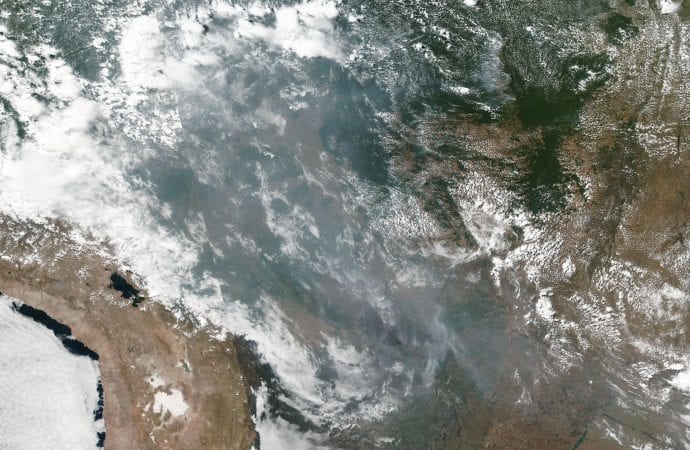At 3 pm on Wednesday, the sun was hidden from one of the world’s most populated cities. São Paulo, Brazil, was not experiencing an eclipse, but instead was blanketed in smoke.
The smoke came from forest fires in the Amazon jungle, which is located approximately 1,600 miles from the city. The fires have been burning at unprecedented rates for the past three weeks.
The bishops of Latin America, seeing the devastation being caused to the region, released a statement on Thursday called “We raise our voice for the Amazon rainforest.”
“The bishops of Latin America and the Caribbean want to raise our concern over the gravity of this tragedy that not only has a local or a regional impact, but of planetary proportions,” the bishops of CELAM - the Latin American bishops’ conference - wrote.
Over 60 percent of the Amazon basin, something that is at the center of an upcoming Vatican summit of bishops from the region, touches Brazil, Peru, Colombia, Bolivia, Ecuador, Venezuela, Guyana and Suriname.
“The hope for the closeness to the Amazon synod, convoked by Pope Francis is now fogged by the pain of this natural tragedy,” the bishops wrote. “To the brothers of the indigenous peoples who live in this beloved territory, we express all our closeness and we unite our voice to yours to show to the world the solidarity and the quick attention to stop this devastation.”
The prelates also urge the governments of the Amazonian countries - particularly Brazil and Bolivia - the United Nations and the international community to take “serious measures” to save the planet’s lungs.
“If the Amazon suffers, the whole world suffers,” they said.
Among the signatories of the statement is Brazilian Cardinal Odilio Scherer, Archbishop of São Paulo.
Quoting Pope Francis’s homily at the beginning of his Petrine ministry, on March 19, 2013, the leadership of CELAM called on those who have “positions of responsibility” to be “protectors of creation, protectors of God’s plan inscribed in nature, protectors of one another and of the environment. Let us not allow omens of destruction and death to accompany the advance of this world!”
The Amazon basin is not immune to fires, but this year’s blazes have been particularly bad, and their impact led the capital city of the Amazon state, Manaus, to declare a state of emergency on Friday.
Wednesday’s smoke over São Paulo was so thick, that NASA photographed it from space, and there are reports that the water in the region is being contaminated.
According to Brazil’s National Institute for Space Research (INPE), the fires are burning at the highest rate since the institute began tracking them in 2013.
INPE noted that so far this year there have been 72,843 fires in Brazil, with more than half in the Amazon region. That’s more than an 80 percent increase compared with the same period last year.
INPE estimates that more than 1½ soccer fields of Amazon rainforest are being destroyed every minute of every day. Most of the fires were started by farmers clearing their lands, and even though they’re mostly burning in uninhabited areas of the forest, they’re beginning to intrude into populated areas in northern Brazil.
Since the 1970s, nearly 497,000 square miles of Brazil’s original 1.5 million square miles of Amazon forest has been lost to logging, farming, mining, roads, dams and other forms of human development. Environmentalists note that in the past year, since rightwing populist Jair Bolsonaro took over the presidency of Brazil, the rate of deforestation has grown and it’s the highest it’s been in a decade.
On Wednesday, Bolsonaro claimed the fires were caused by nongovernmental organizations, who are setting the fires in retaliation for having their funding cut.
“It could be, it could, I’m not saying it is, a criminal action by these NGO people to call attention against me, against the Brazilian government,” he said, providing no evidence to back the accusation. “This is the war we face.”
He said the government was working to control the blazes.
The Amazon produces 20 percent of the oxygen in the Earth’s atmosphere. Scientists have warned that eventually the region could become a dry savannah, no longer habitable for much of its wildlife.
The basin is considered vital in slowing global warming, and it is home not only to indigenous peoples, many of whom live in isolation, but also countless species of fauna and flora.
The Synod of Bishops on the Amazonian region will meet next October in Rome, convoked by Francis, who described it as a direct result of Laudato Si’, a papal encyclical published in 2015 dedicated exclusively to the environment. In the pope’s words, the document is not a “green encyclical” but a “social one,” rooted in a “green reality: The care for creation.”
The synod is an “urgent” gathering, not of scientists and politicians, but for the Church, Francis said, noting that the main discussion of the gathering will be evangelization. However, the region’s biodiversity will also be part of the agenda.
According to Francis, the Amazon basin is a “representative and decisive place,” that together with the oceans plays a key role guaranteeing the survival of the planet.
“Much of the oxygen we breathe comes from there. That’s why deforestation means killing humanity,” he told the Italian daily La Stampa on Aug. 9. “And then the Amazon involves nine states, so it doesn’t concern a single nation. And I’m thinking of the richness of the Amazonian plant and animal biodiversity: It’s wonderful.”

